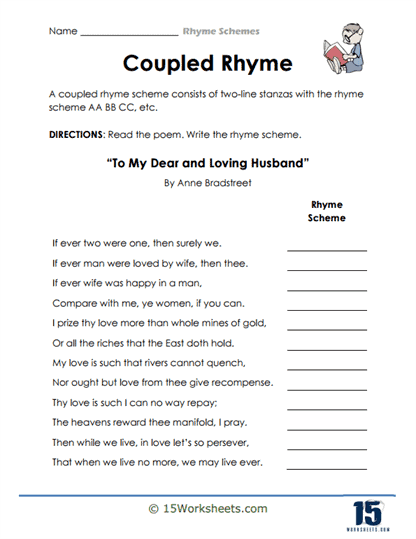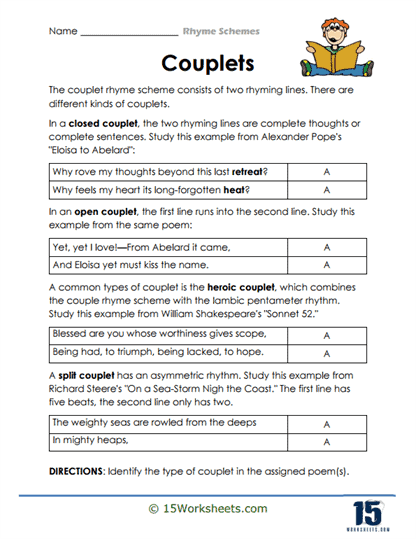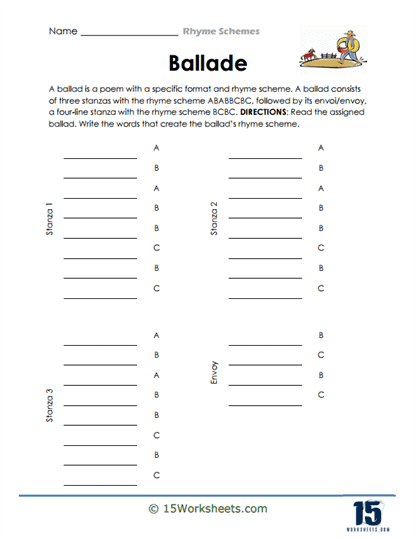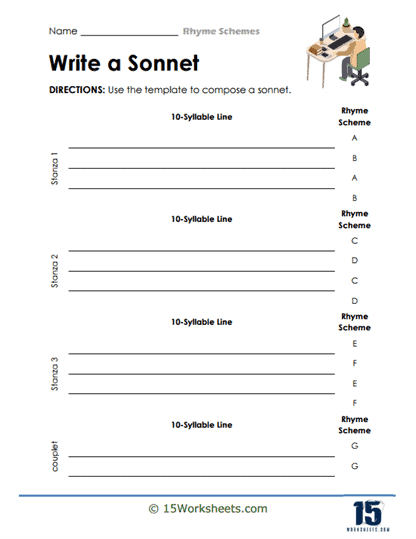Rhyme Schemes Worksheets
All About These 15 Worksheets
Rhyme scheme worksheets will teach students the concept of rhyme patterns in poetry. Rhyme schemes are an essential element in many poetic forms, adding structure and unity to a poem by creating an ordered pattern of rhymes at the ends of lines. These worksheets are useful for teachers, tutors, homeschoolers, and anyone interested in teaching or learning about poetry and its various forms.
The worksheets typically start by explaining what rhyme schemes are and how they work. A rhyme scheme is usually indicated by letters, with each line of poetry assigned a letter based on its end sound. If two lines rhyme, they are assigned the same letter. For example, in the common rhyme scheme AABB, the first and second lines rhyme with each other, and the third and fourth lines rhyme with each other, forming two pairs of rhyming lines.
From the provided images of the worksheets, we can see that they cover several different types of rhyme schemes, each accompanied by exercises and examples to help students practice and understand these patterns. Here’s an overview of what you might expect to find in this type of collection of worksheets:
Basic Rhyme Scheme Identification – Students are introduced to poems or excerpts where they must identify the rhyme scheme. They are given lines of poetry and asked to write down the corresponding rhyme scheme using letters (A, B, C, etc.). For example, a famous poem like “The Road Not Taken” by Robert Frost is broken down into its rhyming patterns, and students label each line accordingly. This kind of activity helps students understand the fundamentals of rhyme schemes.
Limericks – Limericks are a specific form of five-line poetry with a rhyme scheme of AABBA. These worksheets include limerick examples, explaining the rhythm and syllable patterns that accompany the rhyme scheme. Students are tasked with identifying the rhyme scheme in limericks or creating their own. The structured, rhythmic nature of limericks makes this exercise engaging for learners, and it’s a playful way to explore rhyme schemes.
Alternate Rhymes – Also known as ABAB rhyme schemes, alternate rhyme exercises help students practice identifying and labeling poems where every other line rhymes. These worksheets usually provide poems in which students fill in the rhyme scheme for alternating rhymes, such as ABAB CDCD. This form is common in ballads and many forms of classic poetry.
Triplets and Terza Rima – Triplet rhyme schemes involve three rhyming lines in a row (AAA). These worksheets explain how triplets are used in poetry and allow students to explore this scheme through exercises. Terza rima is a more complex rhyme scheme with three-line stanzas, often following the ABA BCB CDC pattern, which connects each stanza. The worksheets guide students through identifying and writing terza rima stanzas.
Couplets – Couplet rhyme schemes (AA, BB, CC, etc.) consist of pairs of rhyming lines. These worksheets include various types of couplets, such as closed, open, and heroic couplets. Students learn how different forms of couplets are used in poems and are asked to label or compose couplets themselves. This offers insight into the compact, impactful nature of couplets in poetry.
Enclosed Rhyme (ABBA) – Enclosed rhyme schemes are used when the first and fourth lines rhyme, while the second and third lines rhyme, forming an ABBA pattern. This scheme is common in sonnets, and students work on identifying this rhyme structure in well-known poetic examples.
Sonnet Rhyme Schemes – Sonnets, a formal type of poetry, often use more intricate rhyme schemes. The worksheets explore various sonnet forms, including the Shakespearean (ABABCDCDEFEFGG) and Petrarchan (ABBAABBA followed by different variations). Students are taught how to label these complex rhyme patterns and how rhyme shapes the sonnet’s form.
Matching Exercises – In addition to rhyme identification, the worksheets may include matching exercises where students pair a rhyme scheme (such as AABB, ABAB, etc.) with its name (limerick, couplet, alternate rhyme, etc.). This reinforces their understanding of different poetic forms and rhyme patterns.
Poem Creation – Some exercises encourage creativity by asking students to write their own poems using specific rhyme schemes. For instance, they may be tasked with creating a quatrain (a four-line stanza) with an ABAB rhyme scheme or a couplet that follows the AA rhyme pattern. This helps students not only understand rhyme schemes theoretically but also apply them in practice.
Historical and Literary Examples – The worksheets often include examples from well-known poets such as Robert Frost, John Keats, and Alfred Lord Tennyson. These literary examples provide context and allow students to see how different rhyme schemes are used in classic poetry. Analyzing such poems helps students appreciate the impact of rhyme schemes on tone, flow, and meaning in poetry.
What Are Rhyming Schemes?
Rhyme schemes refer to the ordered pattern of rhymes at the end of the lines in a poem or verse. It helps to create a rhythm or musicality in the poem, making it more engaging for readers or listeners. When a poem follows a particular rhyme scheme, the end words of certain lines rhyme in a structured manner, such as ABAB or AABB, where similar letters represent rhyming lines. The arrangement of rhymes is not only a stylistic choice but also adds to the poem’s overall meaning and mood, guiding the reader’s emotional experience.
In the context of phonics, rhyme schemes play a crucial role in helping students develop essential reading and spelling skills. Phonics, which focuses on the relationship between letters and sounds, benefits from rhyme schemes because they enhance students’ awareness of sound patterns and word families. When students are able to identify rhyming patterns, they develop a better understanding of how words sound and are spelled similarly, which can boost their confidence in reading and writing. By recognizing these patterns, students also improve their ability to decode unfamiliar words, as they learn to apply known rhyming structures.
One of the reasons rhyme schemes are effective in teaching phonics is that they make learning fun and memorable. The repetitive nature of rhymes helps young learners retain new vocabulary and concepts. Children often find poems and songs enjoyable because the rhyme scheme creates a natural rhythm that enhances engagement. The predictability of rhymes can provide a sense of accomplishment when students successfully anticipate the rhyming word, reinforcing their phonics knowledge. This process also strengthens auditory discrimination, a skill essential for distinguishing between different sounds in language.
Rhyme schemes not only support phonics but also foster creative thinking in students. When students write their own rhyming poems, they must think critically about word choice, meaning, and structure, using language creatively to convey ideas within the constraints of a rhyme scheme. This encourages problem-solving and cognitive development, as students experiment with language to produce meaningful and rhythmic verse. Additionally, writing with a rhyme scheme can help students grasp the broader concept of structure in writing, which is applicable beyond poetry.
Identifying rhyme schemes in poetry helps students become more aware of the various ways language can be organized. It enables them to analyze the author’s intentions and appreciate the art of poetry. By recognizing rhyme schemes like ABAB or AABB, students can explore how rhyme impacts the mood, tone, and flow of a poem. In doing so, they gain deeper insights into the text’s emotional and thematic content, enhancing their analytical skills. This analytical practice also helps students apply the concept of structure in their own writing, leading to more organized and thoughtful compositions.
Examples of Rhyme Schemes in a Paragraph
AABB Example #1
Roses are red, violets are blue,
Sugar is sweet, and so are you.
The sun is bright, the sky is clear,
I feel so happy when you’re near.
In this example, the first two lines rhyme (red/blue), and the next two lines rhyme (clear/near), forming an AABB rhyme scheme.
ABAB Example #2
The night was dark, the stars were bright,
As shadows danced upon the ground,
The breeze was soft, a gentle flight,
While silence made not a sound.
In this example, the first and third lines rhyme (bright/flight), and the second and fourth lines rhyme (ground/sound), forming an ABAB rhyme scheme.















